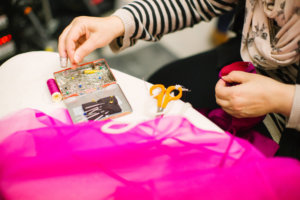Essential Elements: Learn it, teach it, do it

Editor’s note: This column features a different guest writer each month who writes about comical musings, quirky happenings and other essential elements of getting through this thing called life. Care to share? Email your column ideas to Lynn Monty.
The old pamphlet sits on my desk. It’s titled Your First Coat, issued by the Extension Service of the University of Massachusetts and dated August, 1948: Extension Leaflet No. 245. It turned up among the sewing supplies, patterns and fabrics my siblings and I cleaned out of my mother’s house in 2014, the year she died.
The leaflet puts me in mind of a story my mother, Shirley Mackey, occasionally told, always with pride. She had attended a sewing class at the Northampton People’s Institute on Conz Street. The time was 1950; I was in kindergarten at Bridge Street School, and my brother was three. Women in the class—and at that time it would certainly have been only women—learned to make a child’s coat. The method for the class was Learn It, Do It, Teach It. Each student learned how to make a coat by doing it and was then responsible for teach someone else how to make a coat.
The coats were to be made from old garments. In 1950, the U.S. was still getting over the shortages of World War II and struggling with the material demands of the baby boom. Textiles were expensive and still in short supply. The idea was to use a worn adult coat—preferably wool—take it apart at the seams and remove the old lining. The inside of old coats were often in excellent condition: bright, unfaded, no stains. From the old wool, students would make a child’s coat turning the material inside out.
The pamphlet proclaims that savings—payment for your work—can be considerable. “Children’s coats made from the most raddled-looking old garment can be just as attractive as those made from new fabric. They take little material. The cash outlay for a coat you make, can be from 50% to 100% less than the cost of ready-made. So look through your trunks and closets for men’s, women’s, and children’s discarded coats, suits, capes, dresses, and skirts. You may find a GOLD MINE of possibilities.”
The leaflet describes the tools needed: pins, needles, shears, appropriate threads, ironing board, press block, sewing machine, and provides a thorough supply list. There are instructions to launder or dry clean fabrics before use. It even suggests that worn fabric with small holes or tears can be invisibly darned with strands of human hair.
Further instructions include choosing and using a pattern, cutting and hand basting. Also covered are buttonholes, pockets, piping and hemming. It’s clear that this exercise of making a child’s coat contained practically all the skills needed to become an accomplished seamstress.
In that class, my mother made me a coat and leggings with a matching hat from a blue and white herringbone coat that had, she said, belonged to my Grandmother Mackey. There are somewhere, pictures of me wearing the ensemble, completed by a velvet hand muff. The coat it is still, perhaps, in a box or trunk somewhere in my house.
My mother was forever proud of her achievement. She succeeded in making a warm and handsome outfit for me from a worn old garment. She later fulfilled the class commitment and taught a friend to make a child’s coat. The experience was a lynchpin in her life-long love affair with sewing, her creative outlet. My mother was always generous helping others learn to sew. She taught her daughters to sew and supported our efforts, “Yes, I’ll buy the pattern and fabric if you want a new dress,” she’d say. Down town we’d go to Todd’s Department Store to choose fabric and a pattern from a Vogue, McCall’s or Simplicity pattern book. She’d give advice on laying out the pattern and understanding the instructions. Many times she patiently pulled out my mis-sewn seams, saving me—a neophyte seamstress—that dispiriting job.
For all my growing up years, an ironing board and open sewing machine occupied one side of the dining room. Whoever was in charge of setting the dinner table had to carefully stack the pieces of tissue-paper-covered fabric spread across the dining room table onto the ironing board and move scissors, pins, needles and thread to the sewing machine. Only then could the table be set.
When her granddaughters were old enough to sew, Shirley was making fewer garments, but she was in love with quilting. She happily threw herself into helping her granddaughters learn to sew and to make quilts. She told them her story of learning to sew by making the child’s coat from old wool.
My mother enjoyed telling the story for the rest of her life. She was forever proud of that achievement. And certainly, in old age, that distant time of scarcity and the frugal reuse of precious wool represented her youth and her years as a young mother at the end of the Second World War. In the days spent cleaning out her house in 2014, not long before she died, as she pored over photos and china cups and yellowed newspaper clippings, the pamphlet came to light and she told her coat story—an origin myth—once again.
